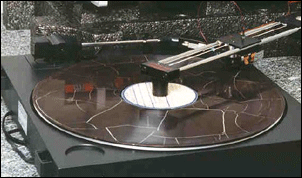…presenting yet another addendum to my series of vinyl trivialities.
Alternate playback methods
I’ve turned up (and had suggested to me) a number of interesting variations on record playback whilst ‘researching’ vinyl oddities. On the ridiculous audiophile end of the spectrum are laser-based turntables. I’ve found two examples implementing this idea differently, one a collegiate study and the other a commercial venture based in japan.
The Japanese ELP Corporation offers their fully-featured laser-based playback system for the paltry sum of $14,300. If you visit this page, you can sign up to recieve a free demo CD and some literature on the player. I’ve listened to the Demo CD, and can say that while it does seem to improve playback quality, you’d have to be one picky son of a bitch (alternately: filthy, filthy, rich) for the rather slight improvement to be worth fifteen grand.
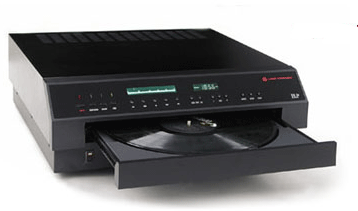
The technically inclined will be interested in this page, detailing the specifics of how playback is accomplished. One huge selling point of such a setup lies in the ability to play damaged records without the characteristic noise. The demo CD includes a track that is claimed to be a recording of a record broken into pieces and reassembled in the tray of the ELP laser turntable. There are still audible pops, but nothing even remotely resembling the cacophony that would ensue if one were to try something similar with a stylus-based player.
ELP Laser Turntable – Broken Record Demo
From: ELP Laser Turntable Demo CD
The academic implementation of this idea can be found here. This implementation uses an optical fiber stylus that contacts the groove ridges in areas undamaged by normal stylii:
“The force applied by the fiber on the record is limited to 60 mg, about 40 time less than that of a modern pick-up. Such a low force is possible because the guiding of the optical head along the groove is obtained by servomotors controlled by optical signals. The system allows the crossing of cracks and small zones without grooves, as frequently observed in ancient records made of a sheet of resin plated on a metallic surface. The spurious audiosignals (tocs, etc…) due to these type of defaults can then be easily removed using common numerical techniques.”
The website has an audio sample (.au) of the playback of the damaged record seen above, as well as a video (.mov) of their player in action.
The most interesting caveat to the modern vinyl-enthusiast when considering a Laser-based turntable solution is the following:
“Clear or colored records are transparent, or translucent, and will not reflect light to the sensors.”
Lo-Fi / Hi-Fi Optical Solutions
Fellow vinyl enthusiast Ofer Springer reasoned that If one were to scan the grooves of a record at a high enough dpi, a program to ‘play’ the images of the grooves could be coded. He made a valiant attempt at producing such a setup in his spare time, and produced the Digital Needle website, where you can listen to the result of his attempts. While the resultant mp3’s are very noisy, traces of the recorded music are audible. He notes that he was not entirely clear on the way sound data is stored in grooves at the time he made these recordings:
“The whole thing was done in a couple of late nights so I didn’t really have much time to gather all the technical details concerning phonograph modulations. Moreover the “archeological” reverse-engineering aspect was part of the fun. I now know (thanks to some great replies) that the horizontal modulation (the only one I did decode) is the sum of the left/right audio channels (which are each encoded on the sides of a V-shaped groove).”
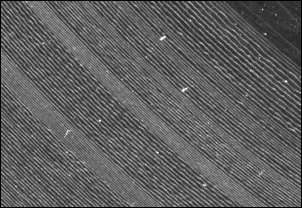
This idea has since been developed further by two physicists at the Lawrence Berkeley National Laboratory in California:
“Carl Haber and Vitaliy Fadeyev have developed a new way to preserve the contents of old discs and wax cylinders: they take pictures of the groove instead of dropping a needle into it. The team shoots thousands of precise sequential images of the groove and then stitches the images together, measuring the shape of each undulation and calculating the route a stylus would take along the path.
“We grab the image and let the computer model what the stylus would have done if it had run through the surface,” said Haber, a senior scientist at the lab who led the research team…”
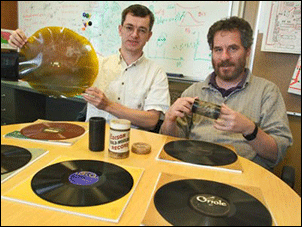
The above quotation was pulled from a New York TImes article that is no longer available online. Further information can be found here and here. Those who are interested in the specifics will be pleased to learn that their 21 page paper on the subject (‘Reconstruction of Mechanically Recorded Sound by Image Processing’) is available online in .pdf form. A few more lines from the NYT article, briefly describing their method:
“One day a few years ago, a radio program that caught their attention prompted them to consider a new application. “We heard a show on National Public Radio on the problems of preserving delicate recordings of the past,” Dr. Haber said. He wondered whether the precision methods the group used for particle detectors might be of use. “Why not just measure the shape of the grooves on the surface?” Dr. Haber said, and then pose the question to a software program: what would a needle do?”
“The physicists began with old 78 r.p.m. discs, on which grooves run laterally, undulating in the plane of the record parallel to its surface. “So from the top down, you can see the groove profile,” Dr. Haber said.”
“The team used a commercially available electronic camera and zoom microscope to acquire images of the grooves. But it was a slow process. It took 40 minutes to scan one second of audio, primarily because the optical tools were not optimized for the task. “It will run much faster when people use a machine built solely for scanning records,” Dr. Haber said.”
Sound files of ‘before‘ and ‘after‘ recordings are available here. The difference is amazing – clear as a bell.
A Human Optical Implementation
Dr. Arthur Lintgen, a Philadelphia physician is able to examine the grooves of records and determine the content of the recording. How does he do it?
“All is explainable – up to a point. First, Dr. Lintgen is a dedicated audiophile with an extensive knowledge of the record catalogue past and present. He can identify only music that he knows, and he guarantees a high rate of success only in orchestral music ranging from Beethoven to the present. Earlier music has a less demonstrable contrast of dynamics, he says, and chamber and solo instrumental music create erratic patterns to the eye. He also prefers newer recordings to the narrower sonic range of early LPs. “I get a lot of these right,” he said. “But I’m much surer within my own limits.” This range excludes excerpts or suite arrangements, because the length, structuring and order of different movements are part of the doctor’s deductive processes. “I have a knowledge of musical structure and of the literature,” he said. “And I can correlate this structure with what I see. Loud passages reflect light differently. In the grossest terms, they look silvery. Record companies spread the grooves in forte passages; they have a more jagged, saw-tooth look. Soft passages look blacker.”
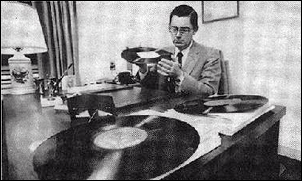
So we see that Mr. Lintgen is not discerning the actual audio content from the grooves, but rather the length and dynamic structure of the music. Using these findings he is able to identify the piece using his encyclopedic knowledge of orchestral music. Further Reading on Mr. Lintgen’s talents is available here, here, here and here.
Japanese Ingenuity
Regular readers of Boingboing saw a post last week about a japanese vinyl-recording model kit (2). Some insight, provided by Boingboing reader Josh:
“it’s a working model kit that costs about $40. that cup is actually a ’paper’ cup. in fact, it says that you use any paper cup and a regular sewing needle to complete the model. it also says that you can record onto CD-ROMs or ‘the lids off of cups of ramen’!!! that sounds too good to be true, but that’s what the site says. you can then play back whatever you record on it as well. it also gives tips on how to get better sound and one of the tips says to use ‘aluminum bags’ mounted to either a cardboard circle or CD-ROM (because the bags would be too thin) to get good sound (not quite sure what an ‘aluminum bag’ is…). it runs on two batteries, takes only an hour and a half to put together and they say that all you need to make it (that’s not already included in the kit) is scotch tape, a phillips screwdriver and a scissors. of course you also have to provide your paper cup and sewing needle as well…”
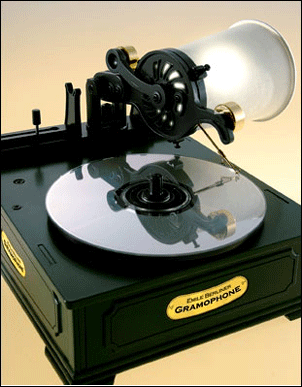
There is a complete translation of the text here. The same site also points out that Amazon Japan has it, but my own efforts to order were thwarted after entering my shipping address (“We’re sorry. This item can’t be delivered to your selected destination. You may either change the delivery address or delete the item from your order by changing its quantity to 0 and clicking the Update button below”).
